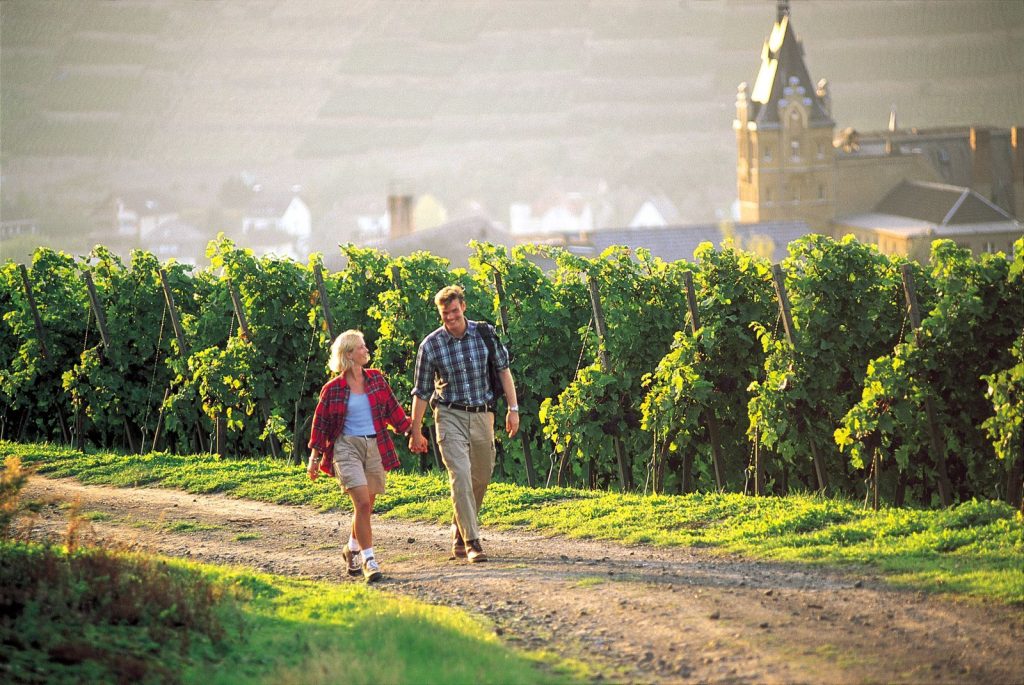Wine Festivals!
When you think of alcoholic beverages in Germany, the first image that likely comes to mind is a tall, frothy glass of beer—perhaps during Oktoberfest celebrations. However, autumn in Germany offers more than just beer. This season is also a time for open-air wine festivals, where locals and visitors gather to celebrate the country’s rich winemaking tradition, experiencing the warmth of German Gemütlichkeit (a sense of coziness and well-being). While German wines have long been known for their sweeter profile compared to Mediterranean counterparts, the diversity of soil types across the country’s wine regions results in a stunning variety of flavors, suitable for any palate.
Germany’s 13 Wine Regions
Germany is home to 13 officially recognized wine regions, each with its own unique customs, traditions, and specialties. The combination of terroir, climate, and grape variety ensures that no two regions are alike, creating an exceptional range of wines. The country’s primary white grape varieties include Riesling, Silvaner, and Rivaner (also known as Müller-Thurgau), while Pinot Noir (Spätburgunder) reigns supreme for reds. Riesling, in particular, is often regarded as one of the finest white wine grapes in the world and is synonymous with German winemaking excellence.
For wine enthusiasts and casual tourists alike, touring Germany’s wine regions has become an increasingly popular autumn activity. The famous German Wine Route (Deutsche Weinstraße) in the Palatinate region is one of the country’s oldest wine roads, stretching through picturesque vineyards, charming villages, and rolling hills. During the fall, many wine-hotels open their doors, offering tastings, fine local cuisine, and warm hospitality, making it an ideal getaway for those seeking both nature and indulgence.
Beyond Wine: Activities for Nature Lovers
Germany’s wine regions are not just for the connoisseur. The beautiful landscapes—complete with undulating hills, winding rivers, and lush, green valleys—make these regions perfect for outdoor enthusiasts. Walkers, hikers, and cyclists can explore a variety of trails that meander through vineyards, forests, and quaint wine villages. The Rhine Valley, for example, offers not only world-class Rieslings but also UNESCO-listed hiking paths and breathtaking views of medieval castles perched high above the riverbanks. For cyclists, the Mosel River region provides scenic routes where you can pedal through ancient villages and stop at wineries to sample crisp whites along the way.
Family-Owned Wineries: Craftsmanship at Its Finest
One of the most charming aspects of the German wine industry is its intimate, family-run wineries. Many of Germany’s vineyards are small-scale operations, where wine production has been passed down through generations. These families often still do much of the work by hand, from harvesting the grapes to pressing them and carefully monitoring the fermentation process. This hands-on craftsmanship shines through in the quality of their wines, offering a personal touch that adds to the overall charm of the region. Visitors are often welcomed into these wineries as if they were guests in the winemaker’s home, creating a friendly and immersive experience.
Exploring Germany’s Wine Regions
Each of the 13 wine regions in Germany offers something unique. Here’s a closer look at some key areas:
Rheinhessen: The largest of Germany’s wine regions, Rheinhessen is known for producing exceptional Rieslings, as well as Silvaner and Dornfelder. The area is a paradise for wine lovers who want to explore vineyards by foot or bike, with small villages like Nierstein offering incredible views over the Rhine.
Mosel: Famous for its steep vineyard slopes and meandering river, the Mosel region is world-renowned for its crisp, mineral-driven Rieslings. The picturesque villages of Bernkastel-Kues and Cochem are must-visit stops for both their wine and their medieval charm.
Baden: Located in the southwest, Baden is one of Germany’s sunniest and warmest wine regions. Here, Pinot Noir (Spätburgunder) thrives, producing elegant and complex red wines. Baden also offers stunning landscapes and thermal spas, making it an ideal destination for relaxation.
Pfalz (Palatinate): Known for its Riesling, this region is also home to Germany’s oldest wine route, the Deutsche Weinstraße. The mild climate here allows for the cultivation of more diverse grape varieties, including Pinot Blanc (Weißburgunder) and Pinot Gris (Grauburgunder), as well as red varietals like Dornfelder.
Saxony: Located in the east, Saxony is one of the country’s smaller wine regions but is quickly gaining a reputation for its light, elegant wines, particularly Weißburgunder (Pinot Blanc) and Müller-Thurgau. The region is also famous for its proximity to the cultural city of Dresden, offering a perfect combination of wine and art.
Franken (Franconia): Known for its unique Bocksbeutel bottle shape, this region produces excellent Silvaner and dry, full-bodied white wines. Franconia is ideal for those who enjoy food and wine pairings, as the region’s cuisine is as impressive as its wines.
German Wine Festivals
Autumn is the season of wine festivals in Germany, and these events are an ideal opportunity to experience local traditions, music, and, of course, wine. Each wine region holds its own festivals, often set in historic town squares or scenic vineyard settings. Some of the most famous festivals include the Deidesheimer Weinkerwe in Palatinate and the Rüdesheimer Weinfest along the Rhine. Here, you can taste a variety of local wines while enjoying traditional German food and entertainment.
Final Thoughts
From the western regions of Rheinhessen and the Mosel to the eastern vineyards of Saxony, Germany’s wine regions offer a vast array of experiences for travelers. Whether you’re a seasoned wine connoisseur or simply someone who enjoys a good glass of wine, there’s no better way to embrace the autumn season than by exploring Germany’s wine culture. Combine this with stunning natural landscapes, warm hospitality, and vibrant festivals, and you have all the ingredients for an unforgettable trip.
For more information visit: www.germany.travel

